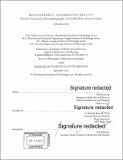Holographic augmented reality : towards near-to-eye electroholography via guided wave acousto-optics
Author(s)
Jolly, Sundeep(Sundeep Kumar)
Download1142630671-MIT.pdf (24.99Mb)
Other Contributors
Program in Media Arts and Sciences (Massachusetts Institute of Technology)
Advisor
V. Michael Bove, Jr.
Terms of use
Metadata
Show full item recordAbstract
Near-to-eye displays act to directly project imagery into a viewer's eye and can range in instantiation from extremely simple (such as an optical viewfinder) to more complex immersive displays for applications in virtual and augmented reality. Many current schemes for near-to-eye display employ stereoscopic techniques; however, such instantiations do not consistently present correct accommodation and vergence cues to the viewer, limiting their potential for seamless, comfortable augmented reality applications. Recent techniques based around light-field display methods show promise in the delivery of consistent depth cues although their applicability in presenting scenery with jointly high spatial and angular resolution is limited. Electroholographic displays have been shown to provide the highest degree of visual realism and consistency amongst cues to depth relative to all competing technologies for 3-D display, and several recent instantiations based around pixelated spatial light modulators have shown their utility for near-to-eye display applications. However, constraints on available space-bandwidth product in such pixelated modulators limit the usable system dtendue, resulting in reduced eyebox or field of view. In contrast, waveguide spatial light modulators offer the potential for displays with extremely high space-bandwidth product, compact form factors, and full-color operation via frequency-division multiplexing. This dissertation aims to assess the feasibility of waveguide-based electroholography for near-to-eye augmented reality display. In particular, such feasibility is assessed through (i) a static set of near-to- eye holograms computed via iterative Fresnel domain techniques and fabricated via grayscale electron-beam lithography and(2) the design and analysis of a fully monolithic photonic platform for transparent, flat-panel holographic display requiring no supporting optics and implemented via anisotropic leaky-mode coupling in conjunction with integrated Bragg-regime diffractive combiner optics in lithium niobate. Furthermore, this dissertation presents a fabrication modality for multiscale, transparent, flat-panel holographic video displays based around femtosecond direct laser writing. Methods for and results in the integration of anisotropic waveguides, volume Bragg reflection holograms, and surface acoustic wave transducers in a lithium niobate substrate are depicted.
Description
Thesis: Ph. D., Massachusetts Institute of Technology, School of Architecture and Planning, Program in Media Arts and Sciences, 2019 Cataloged from PDF version of thesis. Includes bibliographical references (pages 121-128).
Date issued
2019Department
Program in Media Arts and Sciences (Massachusetts Institute of Technology)Publisher
Massachusetts Institute of Technology
Keywords
Program in Media Arts and Sciences